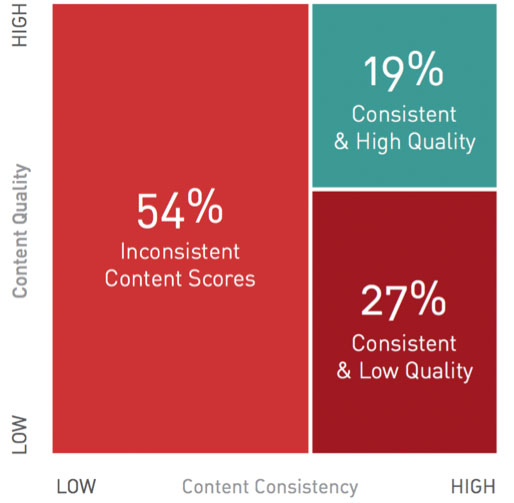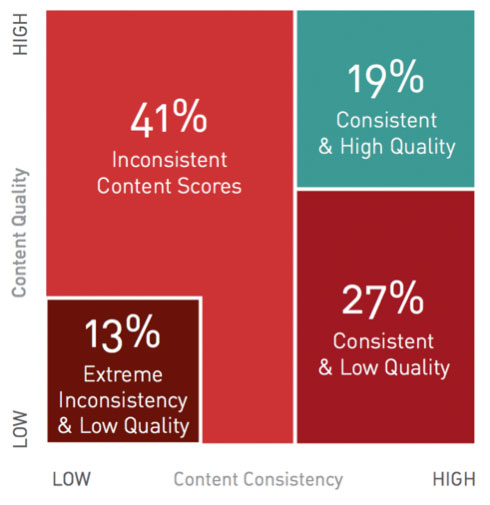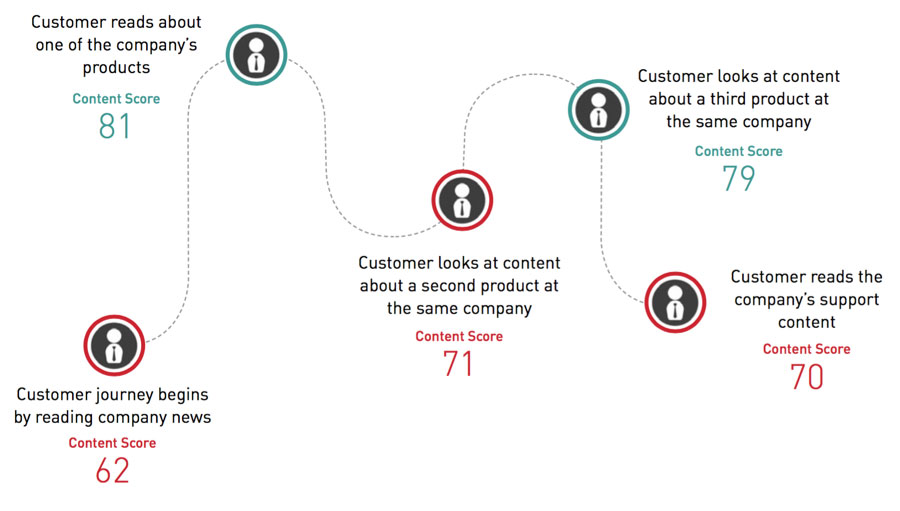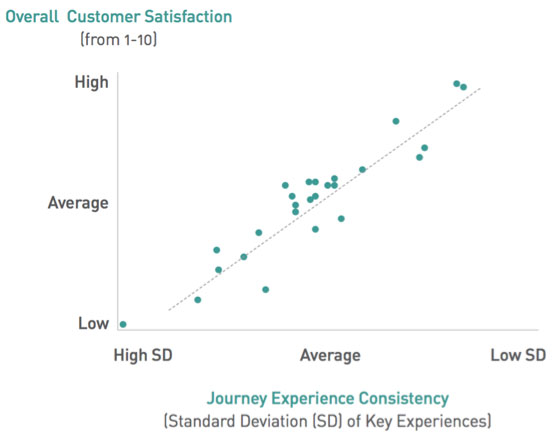People often say that a company’s brand is its most valuable asset, and in many ways I think they’re right. That’s because your brand is your business personified. It’s the way that you look, sound, and act, and it plays a huge role in how people perceive your company. Not surprisingly, companies with great brands stand out, while those that don’t have them often get overlooked.
There are many factors that determine if a brand will be successful, one of the most important of which is whether or not it’s portrayed consistently at every customer touchpoint. When it comes to your content, that means that you always need to sound more or less the same by having a consistent voice, style, and tone.
Unfortunately, maintaining the consistency of your content can be really hard to do at scale. That’s particularly true if you’ve got hundreds or even thousands of content creators in your organization spread across offices all over the world. But when it comes to building your brand, it’s essential.
Let me explain why.
Making the case for consistent content
Jake Sorofman, a vice president at Gartner, noted that “in the game of customer experience… consistency will always trump delight.” The point Jake’s making is as simple as it’s important: Consistency matters. A lot. And, since most companies’ main conduit for communicating with their customers is their content, you can be sure that what you say and how you say it has a critical role to play in shaping those experiences.
It’s also important to point out that when the quality of your content isn’t consistent, it can confuse your customers. For instance, it might create the impression that they’re being sold to by lots of different people rather than a single, unified organization. That, in turn, can damage your brand. On the other hand, when your content is consistent — consistently good, that is — it helps create better customer experiences. That helps you build trust, credibility, and a great reputation.
But don’t just take my word for it. There’s plenty of independent, third-party research out there that supports this. I’ve noted a few of my favorite examples below:
- According to Forrester, having a consistent experience across all brand touchpoints is a key driver of brand trust.
- A study by McKinsey & Company of 27,000 American consumers found that a consistent customer experience across the entire customer journey increases customer satisfaction, builds trust, and boosts loyalty. In a related article, the authors noted: “It may not seem sexy, but consistency is the secret ingredient to making customers happy.”
- The payoff for companies that focus on consistency can be considerable. In fact, research by Techipedia found that consistent brands are worth 20 percent more than those that aren’t.
So while content consistency may seem like a nice-to-have, the reality is that it’s essential for creating the kinds of positive customer experiences that companies need to foster to maximize their success.
Okay, but here’s the thing: Most companies’ content isn’t very consistent. We know first-hand because we’ve done the research that proves it.
Acrolinx’s marketing research on content consistency
Here at Acrolinx, we have a history of analyzing the quality of lots of companies’ content. Building on that work, we recently decided to take that research and analysis a step further.
Rather than simply evaluate the quality of a company’s content overall, we chose to score the different individual types of content that companies publish. I’m talking about things like their corporate communication, marketing, product or service content, and support content. Why? Well, because we wanted to see if all of those different types of content would be of a consistently high level of quality within individual companies. Spoiler alert: They weren’t.
I’m sure I’m stating the obvious, but I should point out here that different types of content are typically written and maintained by different teams, including marketing, tech docs, and product, among others. So while each type of content has a different use, is needed at different points in the buying process, and is written by different teams, they all share a common goal: helping to create great customer experiences.
Fast forward to our research project. Let me give you a quick overview of what we did. Basically, we used our software to score the unique sections of 170 companies’ websites individually, including their blog posts, about us, news, product, and support content. With me so far?
Next, we calculated the variance between the highest and lowest scoring sections within each company, which we used to benchmark the consistency of their content. Based on our research and experience, we determined that companies with a variance of seven points or less have content that’s sufficiently consistent to help them build their brand. On the other hand, in our view, companies with a variance of greater than seven points start to suffer as a result of that inconsistency.
Here’s what we learned about content consistency
The good news is that 46 percent of the companies we analyzed had variance scores of fewer than seven points. In other words, nearly half of the companies are creating content that’s sufficiently consistent so as not to be at risk of brand erosion.

But, as I alluded to before, just having consistent content isn’t good enough. It’s got to be consistently good content.
And that’s where we found some problems. Only a fraction of the companies we looked at proved able to consistently produce high-quality content across their sites that reached or exceeded our benchmark score of 72 (that’s the minimum score that a company’s content needs to achieve to be effective). In fact, only 19 percent of them consistently created high-quality content no matter where in the business it came from.

You don’t have to be a rocket scientist to read between the lines here. What that means is that the vast majority of the companies we analyzed didn’t fall into this category.
In fact, 13 percent of them were at the polar opposite end of the spectrum, not only having low quality content, but also high levels of inconsistency with 15-point variances or more. To put it another way, while all of these companies had content we considered to be low quality, just how bad it was varied considerably from section to section of their websites.

For those 13 percent of companies, having both low-quality and inconsistent content is a real problem. Now while you might be tempted to disregard such a relatively small portion of the total sample as an outlier, don’t forget that less than one-fifth of the companies we reviewed are producing both high-quality and consistent content.
And also don’t forget that that means that the vast majority of companies — 81 percent — need to either improve the quality of their content, ensure that their content is more consistent, or both!
Why should you care?
To better understand what all of this means, imagine that you’re a customer engaging with a brand for the first time. Let’s pretend that your initial point of contact is reading a news item that you find online.
While not particularly well written, the news interests you, so you decide to check out a few of the company’s products. Some of that product content reads well and really speaks to you, and some of it doesn’t.

So what happens?
Well, the company probably starts to feel a bit disjointed to you. Some of the pages you read contain errors, while others don’t. It’s almost as if the company has several distinct voices or personalities. You might even get the impression that the company you’re dealing with is really just a bunch of separate entities that aren’t coordinated or working together.
Sure, that may not be a deal-breaker for you, but it should be an early warning sign that the company you’re dealing with might not be as polished or professional as you’d expect.
Reading some of the company’s Q&As and other support content supports your theory — it’s not as good as some of the product content you just read.
For an increasing number of customers, content inconsistency is a red flag that signals there could be a potential problem. At a time when they expect great customer experiences, and for those experiences to be consistent across the board, even seemingly small details like these can play a pivotal role in purchasing decisions. After all, in a world full of choices, why accept a bad customer experience if a better one might just be a few clicks away?
Topping things off is some research from McKinsey & Company showing the high level of correlation between customer satisfaction and having a consistent customer journey experience. While this particular research is specific to the banking industry, I think it’s fair to speculate that you can expect to find similar correlations in just about any industry.

So what’s driving these inconsistent content experiences?
If publishing inconsistent content is a problem, the question becomes: What’s driving these inconsistent content experiences? Although there wasn’t any one pattern that emerged through our analysis, we identified some trends among the companies with the most inconsistent content.
For example, 25 percent of inconsistent companies had the biggest variance within their product pages.
That means that customers would see a significant difference in the style, clarity, and quality of the content from one product compared to another. This is often the case when different product teams are responsible for developing content for their individual product but fail to align with an overall company-wide strategy for brand, style, and tone. For companies with multiple products but a single buyer, that’s a problem.
Similarly, 23 percent of the companies we surveyed saw the biggest content score variance when comparing their product content with their support content.
For these companies, the old adage of high-gloss marketing vs. monochromatic support content rings true. Their customers would see a material difference between the style, clarity, and quality of the product content and the support content that they engage with. I should point out here that although these content types serve two different purposes, they’re often viewed by the same people. There’s no doubt in my mind that the kind of variances we identified would likely have an impact on brand perception.
The key takeaway here is that if your company has lots of different teams creating content, and no way of standardizing it and ensuring it’s of the highest quality, you really are at risk of damaging your brand.
Where to from here?
As high-quality, consistent customer experiences become increasingly valued by customers, companies will be under the gun to create better, more consistent content. While less than one-fifth of the companies we analyzed are doing this successfully right now, within the next several years we expect that creating consistent, high-quality content will become business-critical.
The question is: Will you be ready when it does?



